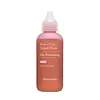What's inside
What's inside
 Key Ingredients
Key Ingredients

 Benefits
Benefits

 Concerns
Concerns

No concerns
 Ingredients Side-by-side
Ingredients Side-by-side

Water
Skin ConditioningButylene Glycol
HumectantGluconolactone
Skin ConditioningGlycerin
HumectantDipropylene Glycol
HumectantPropanediol
SolventTromethamine
BufferingRosa Damascena Flower Water
Masking1,2-Hexanediol
Skin ConditioningPolysorbate 80
EmulsifyingPPG-13-Decyltetradeceth-24
EmulsifyingLactobacillus Ferment
Skin ConditioningEthylhexylglycerin
Skin ConditioningDextrin
AbsorbentTheobroma Cacao Extract
Skin ConditioningDisodium EDTA
Raffinose
Skin ConditioningRosa Damascena Flower Extract
MaskingPunica Granatum Fruit Extract
AntioxidantSodium Hyaluronate
HumectantTocopherol
AntioxidantHydrolyzed Hyaluronic Acid
HumectantPunica Granatum Flower Extract
Skin ConditioningSodium Hyaluronate Crosspolymer
HumectantHyaluronic Acid
HumectantSodium Acetylated Hyaluronate
HumectantWater, Butylene Glycol, Gluconolactone, Glycerin, Dipropylene Glycol, Propanediol, Tromethamine, Rosa Damascena Flower Water, 1,2-Hexanediol, Polysorbate 80, PPG-13-Decyltetradeceth-24, Lactobacillus Ferment, Ethylhexylglycerin, Dextrin, Theobroma Cacao Extract, Disodium EDTA, Raffinose, Rosa Damascena Flower Extract, Punica Granatum Fruit Extract, Sodium Hyaluronate, Tocopherol, Hydrolyzed Hyaluronic Acid, Punica Granatum Flower Extract, Sodium Hyaluronate Crosspolymer, Hyaluronic Acid, Sodium Acetylated Hyaluronate
Water
Skin ConditioningGlycerin
HumectantButylene Glycol
HumectantDipropylene Glycol
Humectant1,2-Hexanediol
Skin ConditioningPortulaca Oleracea Extract
Skin ConditioningPropolis Extract
Skin ConditioningCarbomer
Emulsion StabilisingArginine
MaskingRoyal Jelly Extract
Skin ConditioningLactobacillus Ferment
Skin ConditioningSaccharomyces Ferment Filtrate
HumectantHoney Extract
HumectantPentylene Glycol
Skin ConditioningSodium Hyaluronate
HumectantHydroxyethylcellulose
Emulsion StabilisingDisodium EDTA
Ethylhexylglycerin
Skin ConditioningBeta-Glucan
Skin ConditioningCaprylyl Glycol
EmollientWater, Glycerin, Butylene Glycol, Dipropylene Glycol, 1,2-Hexanediol, Portulaca Oleracea Extract, Propolis Extract, Carbomer, Arginine, Royal Jelly Extract, Lactobacillus Ferment, Saccharomyces Ferment Filtrate, Honey Extract, Pentylene Glycol, Sodium Hyaluronate, Hydroxyethylcellulose, Disodium EDTA, Ethylhexylglycerin, Beta-Glucan, Caprylyl Glycol
 Reviews
Reviews

Ingredients Explained
These ingredients are found in both products.
Ingredients higher up in an ingredient list are typically present in a larger amount.
1,2-Hexanediol is a synthetic liquid and another multi-functional powerhouse.
It is a:
- Humectant, drawing moisture into the skin
- Emollient, helping to soften skin
- Solvent, dispersing and stabilizing formulas
- Preservative booster, enhancing the antimicrobial activity of other preservatives
Butylene Glycol (or BG) is used within cosmetic products for a few different reasons:
Overall, Butylene Glycol is a safe and well-rounded ingredient that works well with other ingredients.
Though this ingredient works well with most skin types, some people with sensitive skin may experience a reaction such as allergic rashes, closed comedones, or itchiness.
Learn more about Butylene GlycolDipropylene Glycol is a synthetically created humectant, stabilizer, and solvent.
This ingredient helps:
Dipropylene glycol is technically an alcohol, but it belongs to the glycol family (often considered part of the ‘good’ alcohols). This means it is hydrating and gentle on skin unlike drying solvent alcohols like denatured alcohol.
As a masking agent, Dipropylene Glycol can be used to cover the smell of other ingredients. However, it does not have a scent.
Studies show Dipropylene Glycol is considered safe to use in skincare.
Learn more about Dipropylene GlycolDisodium EDTA plays a role in making products more stable by aiding other preservatives.
It is a chelating agent, meaning it neutralizes metal ions that may be found in a product.
Disodium EDTA is a salt of edetic acid and is found to be safe in cosmetic ingredients.
Learn more about Disodium EDTAEthylhexylglycerin (we can't pronounce this either) is commonly used as a preservative and skin softener. It is derived from glyceryl.
You might see Ethylhexylglycerin often paired with other preservatives such as phenoxyethanol. Ethylhexylglycerin has been found to increase the effectiveness of these other preservatives.
Glycerin is already naturally found in your skin. It helps moisturize and protect your skin.
A study from 2016 found glycerin to be more effective as a humectant than AHAs and hyaluronic acid.
As a humectant, it helps the skin stay hydrated by pulling moisture to your skin. The low molecular weight of glycerin allows it to pull moisture into the deeper layers of your skin.
Hydrated skin improves your skin barrier; Your skin barrier helps protect against irritants and bacteria.
Glycerin has also been found to have antimicrobial and antiviral properties. Due to these properties, glycerin is often used in wound and burn treatments.
In cosmetics, glycerin is usually derived from plants such as soybean or palm. However, it can also be sourced from animals, such as tallow or animal fat.
This ingredient is organic, colorless, odorless, and non-toxic.
Glycerin is the name for this ingredient in American English. British English uses Glycerol/Glycerine.
Learn more about GlycerinLactobacillus Ferment is created by fermenting the Lactobacillus bacteria. It helps keep our skin's natural barrier and microbiome healthy.
Studies show lactobacillus ferment to be effective at repairing the skin barrier. Having a healthy skin barrier helps keep your skin healthy and hydrated. It also protects against bad bacteria.
As a probiotic/prebiotic/postbiotic, Lactobacillus ferment can help regular our natural biome. In fact, one study found a lack of diversity in our natural skin biome can trigger acne.
Learn more about Lactobacillus FermentSodium Hyaluronate is hyaluronic acid's salt form. It is commonly derived from the sodium salt of hyaluronic acid.
Like hyaluronic acid, it is great at holding water and acts as a humectant. This makes it a great skin hydrating ingredient.
Sodium Hyaluronate is naturally occurring in our bodies and is mostly found in eye fluid and joints.
These are some other common types of Hyaluronic Acid:
Learn more about Sodium HyaluronateWater. It's the most common cosmetic ingredient of all. You'll usually see it at the top of ingredient lists, meaning that it makes up the largest part of the product.
So why is it so popular? Water most often acts as a solvent - this means that it helps dissolve other ingredients into the formulation.
You'll also recognize water as that liquid we all need to stay alive. If you see this, drink a glass of water. Stay hydrated!
Learn more about Water